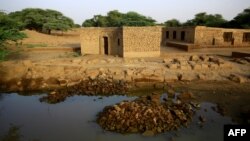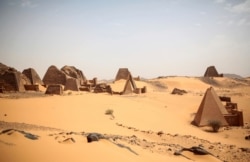Officials in Sudan warn that rising floodwaters could damage ancient structures including Sudan’s Royal City of Meroe if record-setting rains continue.
Two weeks of heavy rain have caused record flooding of the Nile River, which has displaced tens of thousands of people and threatened archaeological sites.
Floodwaters have already damaged the royal bathroom of the Meroe Kingdom, an ancient city on the east bank of the River Nile, about 200 kilometers northeast of Khartoum.
Antiquities experts with the colleges of Khartoum, Nilain and Shendi universities are working to block the floodwaters from entering the ancient sites, said Umaima Hasabarrasul, who works with the Sudan National Museums in Khartoum.
“These sites are under threat of being covered by floodwater. The water level has reached up to 30 cm on part of the wall. We had to call for communal interventions. Through the administrations of various colleges and other partners, we were able to put up more blocks to prevent water. Now we can only say the level of threat has reduced a little bit,” Hasabarrasul told VOA’s South Sudan in Focus.
The Meroe Royal City was the capital of the Kush Kingdom established in 590 BC, which represents a series of early states located within the middle Nile, now part of Sudan. It is one of the earliest and most impressive states found south of the Sahara.
The area was registered with UNESCO as a World Heritage Site in early 2000.
The site is important not only for telling the story of Sudan’s history, but for the African continent and the world because it shows how the Sudanese people contributed to human civilization, said Hasabarrasul.
“The building reflects how Sudan, during the Meroe period, was opened to the world around. They had ties with the Mediterranean Sea cultures. On the wall inside the building, there are graphics that show and express Roman, Greece and Egypt cultures,” Hasabarrasul told VOA.
After visiting the site late last week, Sudan’s information minister, Faisal Mohammed Saleh, told reporters the site is extremely important because it contains archaeological evidence of the Meroe Kingdom.
“The building contains the Amun gods’ temple, it also has the royal bathroom, which is very unique. When the ongoing renovations finish soon, and we hope it will be open for the public and visitors, people will realize its beauty, and its historical meaning,” Saleh told South Sudan in Focus.
Saleh said the previous administration of ousted president Omar al Bashir neglected important historical Sudanese sites for more than 30 years but the transitional government plans to do something about that.
“We shall be announcing a national fundraising from all Sudanese citizens, government, companies and businesses so that we renovate the Royal City. We should all be proud of these antiquities, as we are heading towards achieving lasting peace in the country. Our history should unite all of us and the world should know Sudan’s ancient history through antiquities,” Saleh told VOA.
The Royal City of Meroe also has more than 100 pyramids, part of the largest group of Nubian pyramids. Officials warn that for the first time in history, the pyramids are threatened by flooding.






